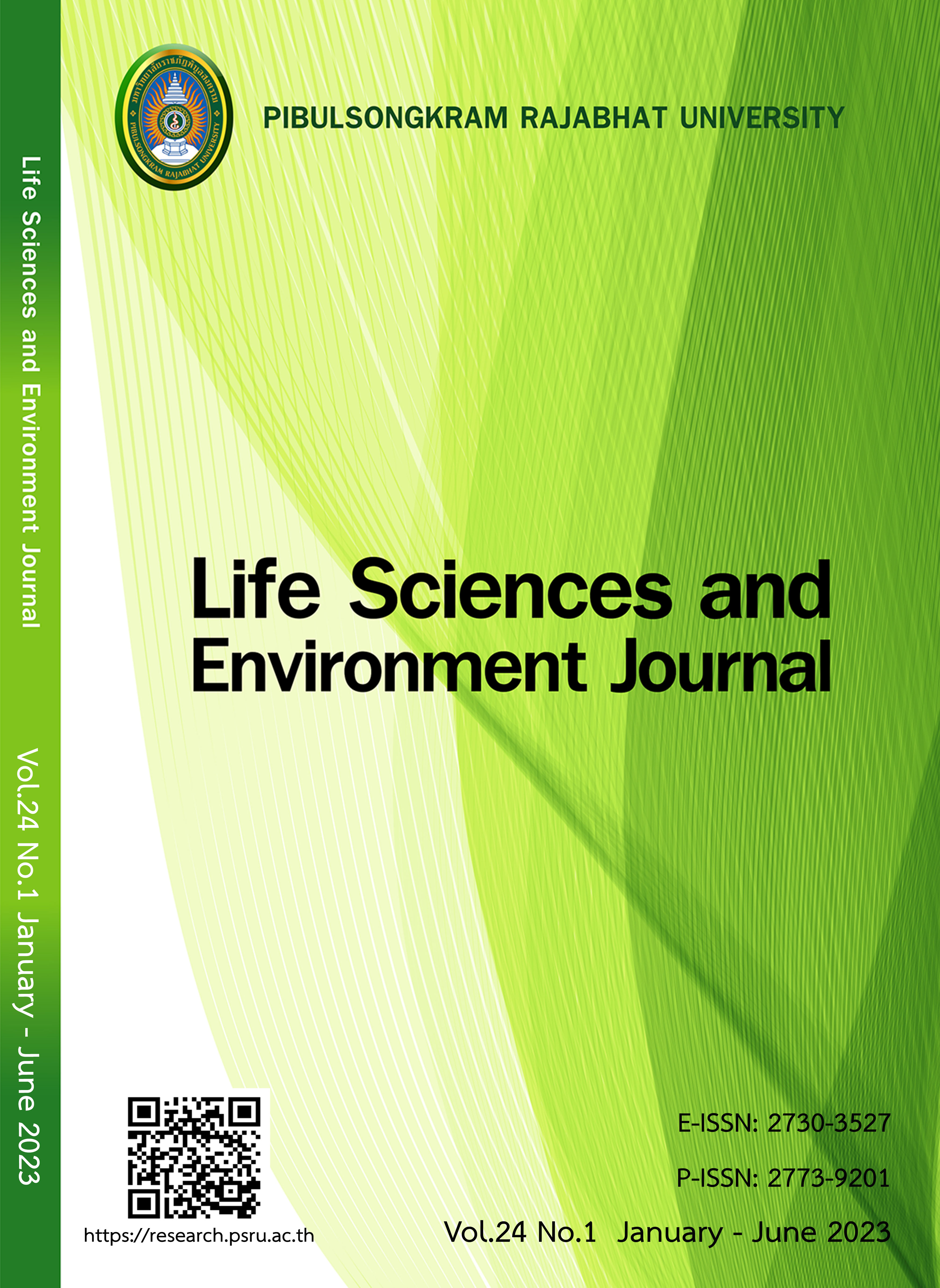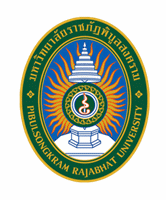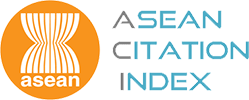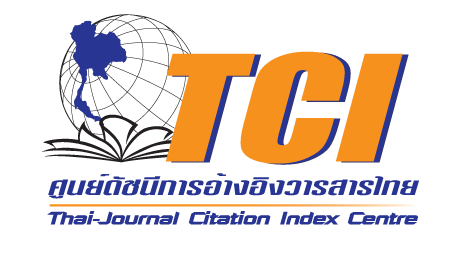การยับยั้งเชื้อ STAPHYLOCOCCUS AUREUS บนผ้าฝ้ายที่ย้อมด้วยสารสกัดจากฝาง
DOI:
https://doi.org/10.14456/lsej.2023.13คำสำคัญ:
การยับยั้งเชื้อแบคทีเรีย , Staphylococcus aureus , ฝาง , ผ้าฝ้ายบทคัดย่อ
A study of an inhibition of Staphylococcus aureus by using three treatments of Caesalpinia sappan L. extracts, extracted by 95% ethanol, was conducted by the disc diffusion method. In addition, the inhibition was examined on cotton jersey fabric (50 mm diameter) dyed with three different treatments of C. sappan extracts, which was modified from the standard test method of AATCC TM 147-2011 Antibacterial Activity Assessment of Textile Materials: Parallel Streak Method. The results of the disc diffusion method showed that the average diameter of the inhibition zone of Treatment 1, Treatment 2, and Treatment 3 was 6.50±0.00 mm, 7.20±0.03 mm, and 9.70±0.06 mm, respectively. Furthermore, the results of inhibition of S. aureus on cotton jersey fabric dyed with C. sappan extracts showed that the average diameter of the inhibition zone of Treatment 1, Treatment 2, and Treatment 3 was 56.50±0.06 mm, 60.60±0.14 mm, and 64.13±0.14 mm, respectively. These results showed that the C. sappan extracts and cotton discs dyed with C. sappan extracts of the three treatments effectively inhibited S. aureus growth, where C. sappan extracts of a Treatment 3 were the most effective in inhibiting S. aureus growth on statistical significance (p≤0.05).
เอกสารอ้างอิง
AATCC. AATCC test method 147-2011 Antibacterial activity assessment of textile materials: Parallel streak method. In AATCC Technical Manual 2015. North Carolina: American Association of Textile Chemist and Colorists; 2015: 275-276.
Al Badri FM. Surgical mask contact dermatitis and epidemiology of contact dermatitis in healthcare workers. Current Allergy & Clinical Immunology 2017;30(3):183-188.
Athinarayanana G, Ranjitsingh AJA, Usha Raja Nanthini A, Padmalatha C. Toxicological studies of Caesalpinia sappan wood derived dye in Wister albino rats. Food Sci Hum Wellness 2017;6(1):34-38.
Batubara I, Mitsunaga T, Ohashi H. Brazilin from Caesalpinia sappan wood as an antiacne agent. Journal of Wood Science 2010;56:77-81.
Chulavatnatol M. Biochemistry. Bangkok: Department of Biochemistry, Faculty of Science, Mahidol University; 1999.
Clinical and Laboratory Standards Institute (CLSI). Methods for dilution antimicrobial susceptibility test for bacteria that grow aerobically; approved standard-eighth edition. CLSI documents M07-A8. Pa: Clinical and Laboratory Standard Institute; 2009.
Department of Thai Traditional and Alternative Medicine. Manual of zoning of cultivation areas for medicinal plants used in Thai traditional pharmacy. Bangkok: WVO officer of Printing Mill; 2015.
Hilgenberg B, Prange A, Vossebein L. Testing and regulation of antimicrobial textiles. In Sun G (Ed.), Antimicrobial Textiles. UK: Woodhead Publishing; 2016: 7-18.
Institute of Dermatology. Statistical information and overview of patient service information of Institute of Dermatology. 2021. Available at: https://shorturl.asia/TyRxv. Accessed December 1, 2022.
Jangetlead M. Introduction to textile science. Bangkok: Horatanachai Printing Ltd., Part.; 1998.
Kankamol C. Antibacterial, antioxidant and anticancer activities of the Caesalpinia sappan L. extract. Thai Science and Technology Journal (TSTJ) 2021;29(2):307-317.
Kim KJ, Yu HH, Jeong SI, Cha JD, Kim SM, You YO. Inhibitory effects of Caesalpinia sappan on growth and invasion of methicillin-resistant Staphylococcus aureus. Journal of Ethnopharmacology 2004;91(1):81-87.
Meesup P, Buachard S. Efficiency of plant extracts against Staphylococcus aureus and Escherichia coli. Agricultural Science Journal 2018;49(2):485-488.
Nirmal NP, Rajput MS, Prasad RGSV, Ahmad M. Brazilin from Caesalpinia sappan heartwood and its pharmacological activities: A review. Asian Pacific Journal of Tropical Medicine 2015;8(6):421-430.
Nirmal NP, Panichayupakaranant P. Antioxidant, antibacterial, and anti-inflammatory activities of standardized brazilin-rich Caesalpinia sappan extract. Pharmaceutical Biology 2015;53(9): 1339-1343.
Nitiyaphat W. Principles of textile dyeing. Bangkok: Department of Home Economics, Faculty of Science, Srinakharinwirot University; 2016.
Panthong S. Antibacterial activity against foodborne pathogen and anti-inflammatory activity of Caesalpinia sappan heartwood. Journal of Thai Traditional and Alternative Medicine 2022; 20(3):597-604.
Puakpong S, Sangsawang J, Arirob W, Phattarakunamorn K, Phadpin A. Antibacterial activity textile and care product from natural extract for the elderly. Bangkok: Kasetsart University; 2021.
Rangsipanuratn W, Kammarnjassadakul P, Janwithayanuchit I. Antibacterial activities of ten Thai herbal extracts against Staphylococcus aureus ATCC 25923, Bacillus cereus and Escherichia coli ATCC 25922. HCU Journal 2016;19(38):35-48.
Saenprakob P, Saengmanee K. Development of facial cleansing anti-acne gel formulation using Terminalia chebula extract. Wichcha Journal Nakhon Si Thammarat Rajabhat University 2020; 39(2):87-100.
Sireeratawong S, Piyabhan P, Singhalak T, Wongkrajang Y, Temsiririrkkul R, Punsrirat J, Ruangwises N, Saraya S, Lerdvuthisopon N, Jaijoy K. Toxicity evaluation of sappan wood extract in rats. Journal of The Medical Association of Thailand 2010;93(7):50-57.
Srinivasan R, Selvam GG, Karthik S, Mathivanan K, Baskaran R, Karthikeyan M, et al. In vitro antimicrobial activity of Caesalpinia sappan L. Asian Pacific Journal of Tropical Biomedicine 2012;2(1):136-139.
Srisukho P, Sangchan N, Jaisuda T, Boonthon K. A study of natural color from mangrove plants at tambol Boh, ampur Klung, Chantaburi province by community participation process. Rajabhat Rambhai Barni Research Journal 2019;13(1):64-73.
Suntarattiwong P. Chapter 47: Vaccine against Staphylococcus aureus infections. In Vaccine Textbook of The Pediatric Infectious Disease Society of Thailand. Bangkok: Pediatric Infectious Disease Society of Thailand; 2011: 615-628.
Swami R, Phaklang P, Setthamongkol P, Kutako M, Hiransuchalert R. Staphylococcus aureus inhibition from phycocyanin extracted from cyanobacteria Arthrospira platensis. Khon Kaen Agriculture Journal 2020;48(1):923-928.
Visutthi M. 2017. Antagonistic effect of Staphylococci of extracts from some local plants in Nakorn-Ratchasima province. KKU Science Journal 2017;45(4):805-816.
WHO Thailand. Advice on the use of masks in the context of COVID-19: Interim guidance, 5 June 2020. 2020. Available at: https://cdn.who.int/media/docs/default-source/searo/thailand/ who-2019-ncov-ipc-masks-2020-4-th.pdf?sfvrsn=61f46597_2. Accessed December 1, 2022.
Wongniraspai M. The study of the effect and safety of Spongilla lacustris with 3% hydrogen peroxide in rat skin. Master of Science (Dermatology), Faculty of Medicine, Srinakharinwirot University; 2009.
Wu SQ, Otero M, Unger FM, Goldring MB, Phrutivorapongkul A, Chiari C, et al. Anti-inflammatory activity of an ethanolic Caesalpinia sappan extract in human chondrocytes and macrophages. Journal of Ethnopharmacology 2011;138(2):364-372.
Yordanova S, Vasileva-Tonkova E, Staneva D, Stoyanov S, Grabchev I. Synthesis and characterization of new water soluble 9,10-anthraquinone and evaluation of its antimicrobial activity. Journal of Molecular Structure 2018;1168:22-27.
ดาวน์โหลด
เผยแพร่แล้ว
รูปแบบการอ้างอิง
ฉบับ
ประเภทบทความ
สัญญาอนุญาต
ลิขสิทธิ์ (c) 2023 Life Sciences and Environment Journal

อนุญาตภายใต้เงื่อนไข Creative Commons Attribution-NonCommercial-NoDerivatives 4.0 International License.
Each article is copyrighted © by its author(s) and is published under license from the author(s).










